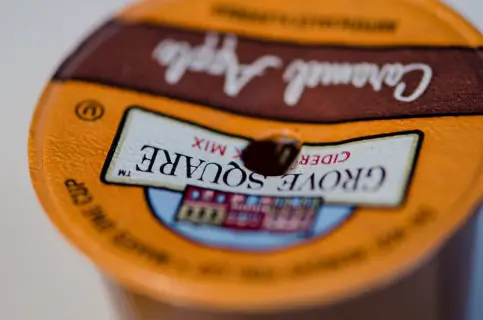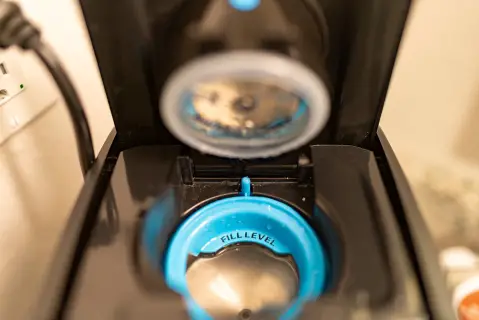A Keurig machine is a convenient appliance to own, especially if you drink coffee or tea on a regular basis. However, if you’re faced with a situation entailing the Keurig machine’s bottom needle not puncturing the K-Cup correctly, your beverage may not come out as you expect. In this guide, we’ll discuss some common reasons why this might be happening and provide tips for how to troubleshoot the problem. We’ll also show you how to properly clean your Keurig so that it functions optimally.
Table of Contents
Reasons for a Keurig’s Needle Not Piercing the Cup
You’re Not Using the Right Cup
The size and shape of your cup is a big factor for Keurig machines, which is why one of the biggest reasons why its needle is not piercing the cup is an incorrect cup. It can be a cup that’s too small for your model or that the ones you bought are round-bottomed instead of flat. The pin will continue to push, attempting to create the hole, but it will fail due to the nature of the cup. What you must do is obtain the right sort of cup – one that is compatible with the needle.
Cup is Not Placed Properly
The cup must be placed correctly in the holder for the needle to puncture it. Make sure the cup is centered and sits straight with the foil facing upwards correctly before starting the brew cycle.
Cup is Damaged

The Keurig coffee machine is a single-serve brewing system that uses special K-cups. These K-cups are essentially containers of coffee grounds or tea leaves sealed inside a filter paper. To brew a cup of coffee, the Keurig machine punctures the top of the K-cup with a needle and hot water is forced through the K-cup, over the coffee grounds or tea leaves, and into your cup.
If the K-cup is damaged, for example, if the foil seal is not intact or if the filter paper is ripped, it may not be strong enough to withstand the pressure of the needle and could break before it is punctured or the needle may not be able to puncture the K-cup. This can cause your Keurig machine to malfunction and will prevent you from being able to brew a cup of coffee.
Pod is Not Filled Properly
This is one of the most common reasons why a Keurig machine needle may not puncture. If there is not enough coffee in the pod, the needle will not be able to puncture it and make a hole because there isn’t enough push back for the needle to puncture it. Additionally, if the coffee grounds inside the pod are not distributed evenly, it could cause the pod to be misshapen and difficult for the needle to puncture.
Another reason why an incorrectly-filled pod may prevent your Keurig machine’s needle from puncturing is that the pod is not made of a material that can be punctured easily. Some materials, such as thick foil, are not meant to be punctured and can cause damage to your Keurig machine if you try to puncture them. If you are using a pod that is not made of a puncturable material, you may need to find a different type of pod to use with your Keurig machine.
Needle is Bent
If the bottom needle is bent, it will not be able to puncture through the pod’s lid. A bent needle can’t puncture for a few reasons. The sharp point may not hit the lid straight enough to puncture it or maybe the needle is not long enough to reach the lid. As a result, a bent needle cannot puncture the pod or cup and make a hole for the water to go through to the grounds.
There are a few ways to fix this problem. One is to use a longer, sharper needle, or use a paperclip or pipe cleaner to straighten out the existing needle. Finally, you can try heating up the k-cup with a hair dryer or other heat source before placing it inside the holder. This will soften the plastic and make it easier for the needle to penetrate. Whichever method you choose, be sure to take care not to puncture your finger in the process!
Needle Broke Off
A needle that’s broken off won’t puncture anymore. But this doesn’t mean you can’t do anything about it. There are a few things you can do to fix the problem. First, try gently pushing the needle back into place. If that doesn’t work, try using a pair of pliers to carefully bend the needle back into place. If neither of those options works, you may need to replace the needle altogether. You can find replacement needles online or at your local hardware store. With a little bit of effort, you should be able to get your machine back up and running in no time!
Needle is Clogged
The needle can also become clogged with coffee grounds, calcium deposits or other debris. This can prevent the needle from piercing the coffee pod and creating a seal. Even if it does puncture the pod, the clog can slow the water flow, which in turn slows the Keurig’s brewing process. When faced with the situation, clean the needle with a paperclip or pipe cleaner to clear the way and allow it to puncture again.
Not Enough Water in the Reservoir

Another explanation for why the bottom needle of your Keurig machine is not puncturing is that the water reservoir might not have enough water in it. The water in the reservoir creates downward pressure and pushes the puncturing needle down to pierce the lid if the coffee pod. Add more water to the reservoir and try again.
Pump is Malfunctioning
The bottom needle of your Keurig machine may not be puncturing because the pump is malfunctioning. The pump is responsible for pressurizing the water in the reservoir, and if it’s not working properly, the water won’t be able to create the proper pressure. As a result, the needle won’t be able to puncture through the seal on the K-Cup.
Now that you’ve studied all the possible reasons why your Keurig machine’s bottom needle is not puncturing, let’s find out how to perform needle maintenance on a keurig. This will eliminate most of the issues discussed above, and prolong the life of your Keurig machine and its needle.
How to Perform Needle Maintenance on a Keurig
If you own a Keurig coffee maker, then like any coffee maker, your Keurig will eventually require some maintenance in order to keep it running smoothly. One of the most important things you can do for your Keurig is to regularly perform needle maintenance.
The needle on your Keurig is responsible for puncturing the coffee pod so that hot water can flow through and brew your coffee. Over time, this needle can become clogged with coffee grounds or other debris. When this happens, your Keurig may not work properly and you may not be able to get a good cup of coffee. In order to keep your Keurig working properly, you should perform needle and general maintenance at least once a month. The easiest maintenance routine would be to get the Keurig Brewer Maintenance Kit that includes a descaler, rinse pods, and water filter cartridges.
Here are two key tips to perform needle maintenance:
Descale Your Keurig Machine
One of the most important things that you can do is to descale your machine on a regular basis. Descaling helps to remove any mineral buildup that can occur over time. This mineral buildup can cause the needle to become clogged and eventually break. It can even result in the brewing temperature of your coffee maker to be not hot enough. You should descale your machine at least once every three months, but more often if you live in an area with hard water.
Regular Cleaning
Another maintenance tip is to clean the needle after each use. This helps to remove any coffee grounds or other debris that may be clinging to the needle. Simply rinse the needle with warm water and then dry it with a clean cloth. You should also take the time to clean the inside of the machine on a monthly basis. This includes wiping down the surfaces and taking care of any coffee grounds that may have accumulated.
FAQs
Keurig machines represent a coffee brewing system that uses small, single-serve pods of coffee. These pods are placed into a special brewing machine, which punctures the pod with two needles in order to brew the perfect cup of coffee. There exist two needles that work simultaneously. One of them, often referred to as the entrance needle, punctures a hole at the top of the K-cup, and another that’s called the exit needle makes a hole at the bottom.


